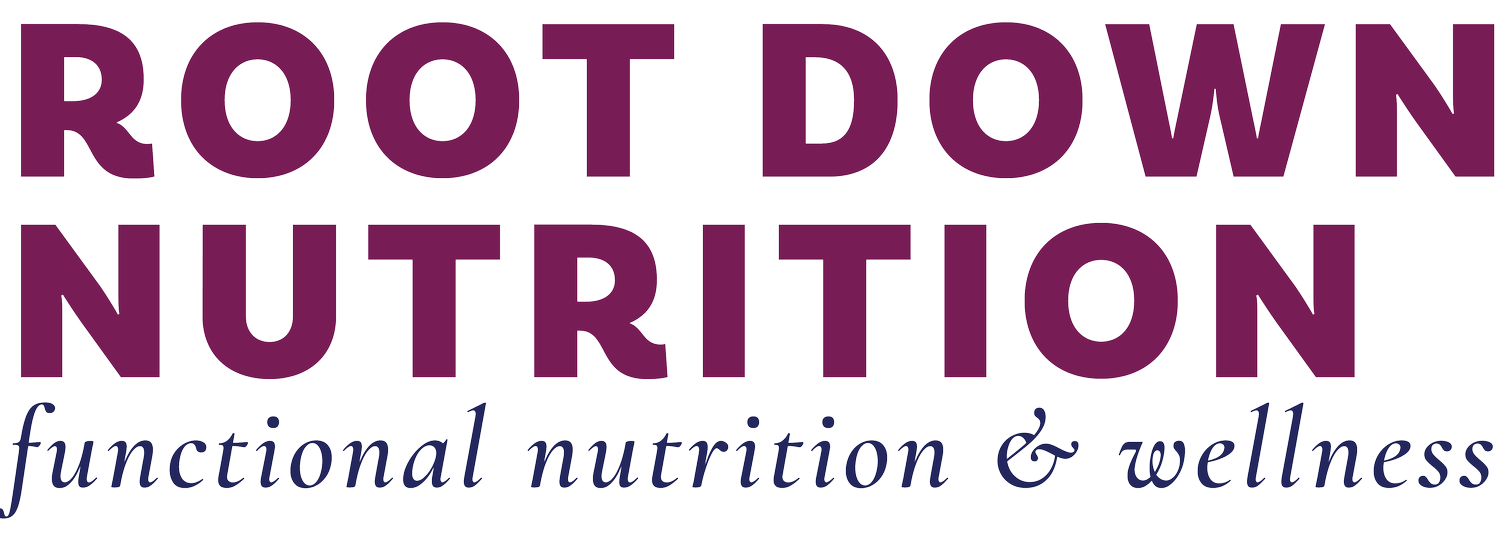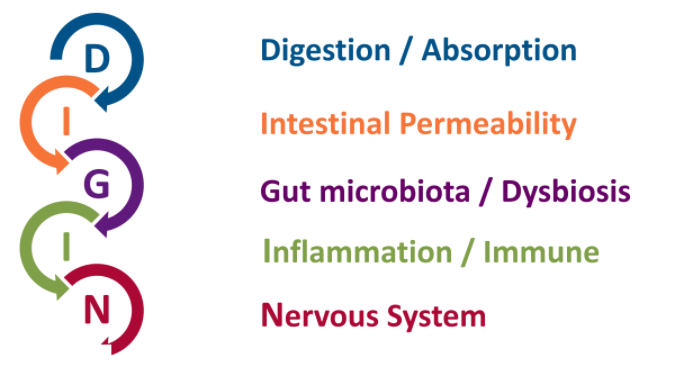The Main Causes of Digestive Imbalances & How to Fix Them, Part 1
Part 1: Assessment using the DIGIN model
In conventional medicine, once a diagnosis is made a standard treatment is given and pharmaceuticals are often recommended to provide symptom management. The same approach happens in conventional dietetics where a specific diet is recommended based on the diagnosis you’ve been given.
In functional medicine and nutrition, there is no standard treatment based solely on a diagnosis or set of symptoms. Instead, we work to identify the specific root causes behind a person's symptoms and disease so a personalized plan of action can be created.
The goal is to focus on the root cause of disease and dysfunction while providing a patient-centered approach that acknowledges the different diets, lifestyles, and genetic makeup that makes us all unique from one another.
Simply put, three people diagnosed with Irritable Bowel Syndrome (IBS) would be treated the same way by conventional medicine and nutrition. In functional medicine and nutrition, those same three people with IBS could each have a different root cause behind their symptoms (more on this below) which would result in a different treatment approach for each of them.
Without a personalized approach, you’re just matching a diagnosis or set of symptoms to a drug or diet and calling it a day.
So, what are the underlying causes behind your digestive symptoms?
DIGIN is an acronym for the five primary categories of digestive imbalances. This can make it easier to see why a personalized approach is essential for true gut healing.
Let’s dig into it!
Photo from Institute for Functional Medicine
D: Digestion/Absorption
If you can’t digest and absorb your food, your cells won’t get the nourishment they need to function optimally. This is a very common area for people to have issues in and can be a big reason behind your gut symptoms like diarrhea, gas, bloating, abdominal discomfort, constipation, and more.
What kind of problems can you have around digestion and absorption?
Poor meal hygiene from not chewing your food enough, rushed eating, eating while stressed or on the go
Digestive insufficiency from low stomach acid (HCl), bile salts or digestive enzymes
Inadequate dietary fiber which can lower your good bacteria and negatively impact motility
Impaired motility from food moving through too fast or slow (diarrhea or constipation) through the digestive tract
How can you optimize digestion and absorption?
Take 5 deep breaths before a meal, aim to have meals take at least 20 minutes to finish, chew each bite 30 times, and stop eating on the run or while multitasking.
I: Intestinal Permeability
Increased intestinal permeability (aka leaky gut syndrome) is a symptom of inflammation and imbalance. It is not a disease or an illness.
Our intestinal tract is lined by a single layer of cells that make up the mucosal lining and act as the barrier or gateway between our digestive tract and bloodstream. There are two main functions of the mucosal lining. The first is to allow nutrients from properly digested food to pass through into our bloodstream so our body can use them. The second is to act as a barrier to keep waste, toxins, large undigested food molecules, and harmful bacteria out of our bloodstream where it doesn’t belong.
When the mucosal lining has become damaged because of inflammation and irritation, the barrier starts to break down and become leaky, letting things get past the barrier where they don’t belong. This can result in many different symptoms like bloating, diarrhea, constipation, food sensitivities, fatigue, joint pain, headaches, skin issues, brain fog. Leaky gut is also a known trigger for autoimmunity.
How can you support your mucosal lining?
Avoid medications like NSAIDs (ex. Advil and Motrin) and excessive alcohol intake which can damage the gut lining.
G: Gastrointestinal Microbiota / Dysbiosis
Dysbiosis is when the gut microbiome is out of balance.
What causes an imbalance in your microbiome?
Chronic intestinal inflammation
Not digesting and absorbing your food properly
Having too much potentially harmful bacteria
Not having enough good bacteria
Leaky gut
Infections from pathogenic bacteria, parasites, fungi, viruses or worms
Dysbiosis will look different person to person. It might show up as IBS for one person, or skin issues like eczema, migraines or depression for someone else.
The best way to determine the cause of your dysbiosis is to work with a provider who will order and interpret a functional stool test for you. This will tell you which one of these causes are at play (there may be more than one) and identify what steps need to be taken to restore balance to your gut.
How can you boost your microbiome?
Eat a whole foods, high fiber diet with lots of variety.
I: Immune Function / Inflammation
Did you know that 70% of our immune system is located in the gut?
The primary job of the immune system is to determine what is self from nonself. The food we eat is considered foreign and since 99% of the time the immune system's job is to not respond, we develop a tolerance for our environment so that we aren’t always reacting to food or even something environmental like pollen.
When we eat a whole foods diet our immune system calms down because these are foods it recognizes. When we eat man made things like soda, trans fat, artificial colors and flavors, chemicals, and heavily processed foods our immune system doesn’t recognize these foods and becomes activated and goes on high alert.
When the immune system is out of balance it creates inflammation. Inflammation could be from an injury, fever, pain, or even eating foods that don’t agree with us. Acute inflammation is a normal response. But things get out of control when inflammation becomes chronic. Chronic inflammation is at the root of all chronic diseases.
Things like dysbiosis, leaky gut, chronic stress, and a poor diet can activate our immune system and cause inflammation in the gut.
How can you decrease inflammation?
Eat the rainbow! Polyphenols are chemicals in plants that not only provide their color but also have anti-inflammatory and prebiotic properties. Berries, beans, fruit, broccoli and chocolate are some examples of foods with high amounts of polyphenols.
N: Nervous system
Our body is controlled by our nervous system; it strives for balance within each part of this complex system. The autonomic nervous system (ANS) houses the sympathetic nervous system (fight or flight) which takes over when we’re in a stressed state. Conversely, the parasympathetic nervous system (rest and digest) kicks in when our body is relaxed. The parasympathetic nervous system is controlled by the vagus nerve, the longest nerve in the body that connects the brain to the gut so they can communicate back and forth with each other. This is known as the gut-brain axis.
Both the sympathetic and parasympathetic nervous systems affect digestion. When a sympathetic state is activated, our body will redirect its efforts away from digestion and put all its energy into our stress response, preparing us for fight or flight.
When we’re in a parasympathetic state, our body is relaxed and able to focus on digestion with ease (rest and digest).
Within the ANS is the enteric nervous system (ENS). The ENS is found in the lining of the gut and is the nervous system that controls digestion.
When we’re in a parasympathetic state, the vagus nerve will send signals to the ENS to stimulate the release of digestive enzymes, control how fast food moves through our stomach and intestines, decrease inflammation and leaky gut, and help us to feel hungry or satiated.
Since our body can’t tell the difference between real or perceived danger, stress and negative thoughts have a profound impact on our digestion. When the ENS receives signals that we’re in a sympathetic state, digestion slows down. It can even be shut down completely in periods of intense stress. A constant state of stress also affects our ability to heal and repair. Stress can contribute to digestive issues like ulcers, inflammation, inflammatory bowel disease (IBD), IBS, constipation, diarrhea, and GERD.
How can you calm your nervous system?
Practice stress management techniques like deep breathing, meditation, yoga, gardening, listening to music, therapy, singing, and prayer. These will strengthen the vagus nerve and tell the body that all is well.
Now that we’ve done a deep dive into the different categories of digestive imbalances, head on over to Part 2 where we’ll go over functional medicine’s 5Rs for gut restoration which can lead to massive improvements in your gut symptoms and oftentimes, complete resolution. Yessss!
If you’re ready to take action and identify your unique root causes of digestive imbalances, click here to apply for an Initial Nutrition Assessment to discuss your symptoms and goals with Kyle and the ways you can work together to fix them!
About Kyle
Kyle Maiorana is a functional medicine Registered Dietitian Nutritionist and real food advocate who takes a whole-person, root-cause, evidence-based approach to wellness. She works with clients to eliminate gut symptoms for good.





